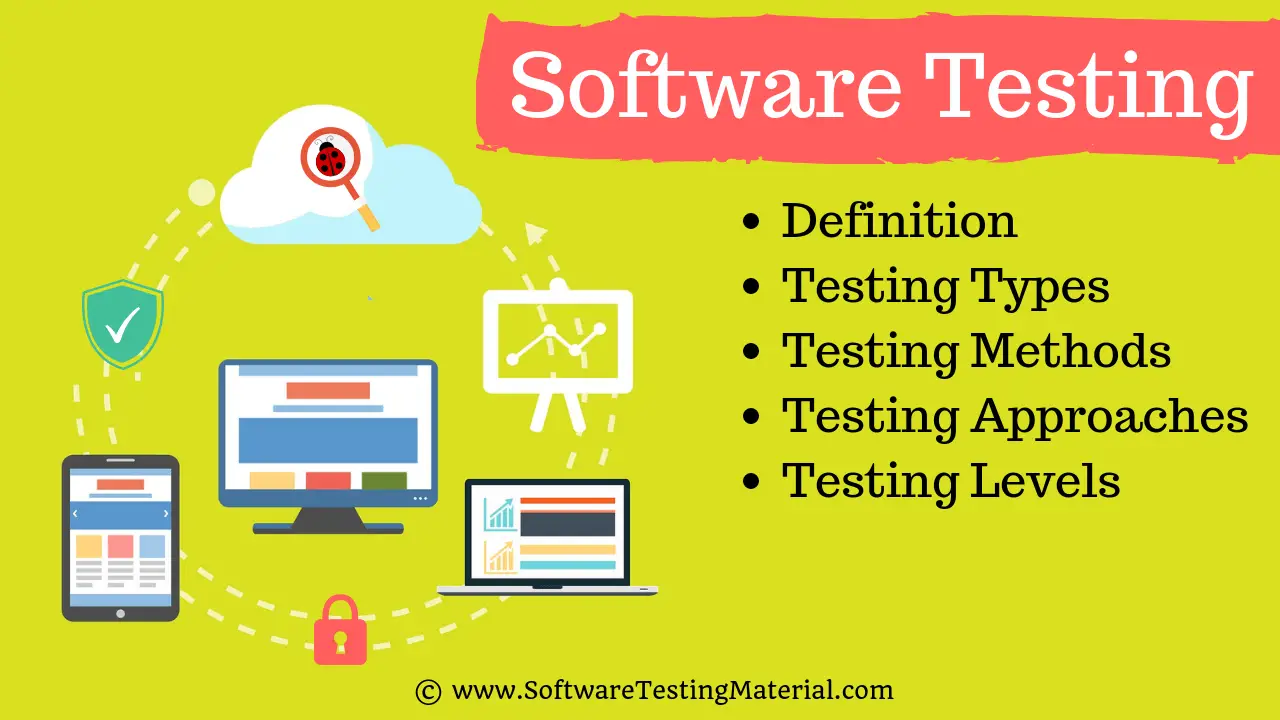What Is Software Testing | Everything You Should Know

Welcome to the world of software testing! This article will guide you through the basics of software testing, helping you understand its importance, methods, and best practices. Let’s get started on this essential journey to making great software!
Software testing is not what it was a decade ago. In the last few years, it has transformed a lot, especially with the introduction of Artificial Intelligence in software testing. AI has brought new tools and techniques that make testing faster and more efficient, helping to catch bugs and improve software quality more effectively.
In upcoming articles, we will delve into the role of AI in software testing. For this article, however, we will focus on the importance of software testing and its key aspects.
If you are involved in software testing, I highly recommend exploring Artificial Intelligence (AI) and Prompt Engineering in Software Testing.
What is Software
Software is a set of instructions or programs that tell a computer what to do. It can be divided into two main categrories ie., system software and application software.
System software includes the operating system and all the utilities that help keep the computer running. Application software includes programs that do specific tasks, such as word processing or playing games.
Other types of software, including: middleware, driver software, programming software.
What is Testing
Testing is the process of checking how effective something is. It involves finding and fixing errors to ensure the quality standards.
What is Software Testing
Software testing is a process, to evaluate the functionality of a software application with an intent to find whether the developed software met the specified requirements or not and to identify the defects to ensure that the product is defect-free in order to produce a quality product. Software testing helps identify problems early, making the software reliable and user-friendly before it is released.
Definition of Software Testing in Software Engineering
According to ANSI/IEEE 1059 Software Testing Standard, Testing in Software Engineering is a process of analyzing a software product or system to examining a software product or system to determine whether it satisfies or fails to satisfy established conditions (i.e., defects). The testing process evaluates the software products characteristics for requirements such as missing requirements, bugs, or errors in order to evaluate its reliability, security, and performance.

History of Software Testing
Software testing has come a long way since it started after World War II. Computer scientist Tom Kilburn is credited with writing the first piece of software on June 21, 1948, which performed mathematical calculations using machine code. Initially, debugging was the primary testing method for two decades.
In the 1980s, the first version of the IEEE 829 Standard for Software Test Documentation expanded testing to include quality assurance, integrated into the software development lifecycle. From the 1990s onwards, software testing methodologies and tools advanced, leading to the modern era of powerful automation tools like Selenium.
Why do we need Software Testing?
When I started my career I had no idea what software testing is and why it is required. I also had no clue where to start. Maybe you are in the same situation as I was long back. Don’t miss these guides how to become a Software Tester and also how to shift your career from manual to automation testing
Software testing is important because it helps us make sure our software does what it is supposed to do. Without testing, the software might have bugs or issues that can cause it to fail or behave incorrectly. Testing helps us find and fix these problems before real users see them. This leads to better performance, higher reliability, and a better user experience. Additionally, early software testing finds bugs early and save us time and money down the road. In short, software testing helps us create safe, reliable software that meets users’ needs.
Some real-life examples on why software testing is important are as follows
- Nissan Cars’ Airbag Sensors Issue: Nissan had to recall over 1 million cars due to problems with their airbag sensors. The issue was that the sensors in the front passenger seats sometimes failed to recognize if a person was seated there. As a result, the airbags might not deploy in a crash, putting passengers at serious risk. The recall was a big deal because it meant a lot of work and expense for Nissan to fix all the affected cars. It also highlighted the importance of thorough testing to ensure the safety and reliability of vehicle systems.
- HSBC Payment Glitch: Another notable example is the HSBC payment glitch. HSBC faced a software failure that stopped approximately 275,000 payments, causing major disruption for businesses and individuals. The fault in the bank’s payment processing software led to delays in salaries and other payments, leaving many customers without funds and sparking frustration and distrust. This incident emphasizes the need for thorough software testing to find and fix bugs or issues before deployment. Proper testing could have prevented the financial and reputational damage experienced by HSBC, ensuring smooth payment processing for their clients.
What if there is No Software Testing in the Software Development Process
As per the current trend, due to constant change and development in digitization, our lives are improving in all areas. The way we work is also changed.
For instance, we access our bank online, we do shopping online, we order food online, and many more. We rely on software and systems.
What if these systems turn out to be defective. We all know that one small bug shows a huge impact on business in terms of financial loss and goodwill.
To deliver a quality product, we need to have tested in the Software Development Process.
Some of the reasons why testing become a very significant and integral part of the field of information technology are as follows. These are the benefits of software testing.
1. Cost-effectiveness
As a matter of fact, design defects can never be completely ruled out for any complex system.
It is not because developers are careless but because the complexity of a system is intractable.
If the design issues go undetected, then it will become more difficult to trace back defects and rectify it. It will become more expensive to fix it.
Sometimes, while fixing one bug we may introduce another one in some other module unknowingly. If the bugs can be identified in the early stages of development then it costs much less to fix them.
That is why it is important to find defects in the early stages of the software development life cycle.
One of the benefits of testing is cost-effectiveness.
It is better to start testing earlier and introduce it in every phase of the software development life cycle and regular testing is needed to ensure that the application is developed as per the requirement.
2. Customer Satisfaction
In any business, the ultimate goal is to give the best customer satisfaction. Yes, customer satisfaction is very important.
Software testing improves the user experience of an application and gives satisfaction to the customers. Happy customers mean more revenue for a business.
3. Security
This is probably the most sensitive and vulnerable part of testing. Testing (penetration testing & security testing) helps in product security.
Hackers gain unauthorized access to data. These hackers steal user information and use it for their benefit. If your product is not secured, users won’t prefer your product. Users always look for trusted products. Testing helps in removing vulnerabilities in the product.
4. Product Quality
Software Testing is an art that helps in strengthening the market reputation of a company by delivering a quality product to the client as mentioned in the requirement specification documents.
Due to these reasons, software testing becomes a very significant and integral part of the Software Development process.
What are the different types of Software Testing?
#1. Manual Testing
Manual testing is the process of testing the software by hand to learn more about it, to find what is and isn’t working.
This usually includes verifying all the features specified in requirements documents, but often also includes the testers trying the software with the perspective of their end user’s in mind.
Manual test plans vary from fully scripted test cases, giving testers detailed steps and expected results, through to high-level guides that steer exploratory testing sessions.
There are lots of sophisticated tools on the market to help with manual testing, but if you want a simple and flexible place to start, take a look at Testpad.
#2. Automation Testing
Automation testing is the process of using automation testing tools to control the execution of tests and compare the results against expected outcomes and to find the defects.
In this process, testers execute the test scripts and generate the test results automatically by using automation tools.
Don’t miss: Manual Testing vs Automation Testing
Some of the famous automation testing tools for functional testing include Selenium, testRigor, and Katalon Studio.
Selenium is no longer a strange name for web application testers. It offers powerful capabilities like cross-browser testing but is difficult to learn for those new to automation or with limited programming experience.
That’s why most QAs freshers and manual testers start out with Selenium Alternatives.
testRigor is one of the best alternatives to selenium.
- It allows you to create stable tests in plain English.
- It allows you to build tests which run in all Desktop and Mobile browsers, and Native mobile applications.
Check out our detailed step by step Selenium Tutorial
When to go for Automation in Software Testing?
Automation in software testing is an important decision that can bring many advantages. Here are some scenarios where you should consider going for automation:
- Repetitive Tasks: If you have tests that need to be run frequently, automation can save a lot of time and effort. Automated tests can run at any time without human intervention.
- Large Datasets: When you need to test with large amounts of data, automation can handle it more efficiently than manual testing.
- Regression Testing: Each time the software changes, regression tests should be run to make sure existing functionality is not broken. Automation makes regression testing faster and more reliable.
- Consistency: Automated tests perform the same steps in the exact same way every time, reducing the risk of human error.
- Performance Testing: For testing the performance and load capacity of an application, automation is essential. It can simulate many users interacting with the system at once.
- Complex Scenarios: When you have complex and lengthy test cases, automation can execute them more quickly and accurately than a manual tester.
These points help in understanding when to go for automation in software testing. It can improve the efficiency and reliability of your testing process, allowing your team to focus on more important tasks.
What Kinds Of Tests To Do Manually?
While automation is valuable for repetitive and extensive test scenarios, some tests are better done manually. Here are a few:
- Exploratory Testing: This involves a tester exploring the application to find bugs that aren’t easy to detect through automated scripts. It relies on human intuition and creativity.
- Usability Testing: This type of testing ensures that the application is user-friendly. Human testers evaluate the ease of use, look and feel, and overall user experience.
- Ad-hoc Testing: These are unplanned tests without any specific approach. Testers randomly test different parts of the application to find unexpected issues.
- User Interface (UI) Testing: This involves visually examining the interface to check for visual elements, like layouts, fonts, and colours. Although automation tools can assist, human eyes often catch things machines might miss.
- Accessibility Testing: Manual testers check if the application is usable by people with disabilities, ensuring adherence to accessibility standards like WCAG.
Testing Methods
- Static Testing
- Dynamic Testing
#1. Static Testing
It is also known as Verification in Software Testing.
Verification is a static method of checking documents and files.
Verification is the process, to ensure that whether we are building the product right i.e., to verify the requirements which we have and to verify whether we are developing the product accordingly or not.
Activities involved here are Inspections, Reviews, Walkthroughs
#2. Dynamic Testing
It is also known as Validation in Software Testing.
Validation is a dynamic process of testing the real product.
Validation is the process, whether we are building the right product i.e., to validate the product which we have developed is right or not.
Activities involved in this is Testing the software application (Desktop application, Web application, Mobile Apps)
Read more on Static and Dynamic Testing.
Types of Software Testing Approaches
There are three types of software testing approaches.
- White Box Testing
- Black Box Testing
- Grey Box Testing
#1. White Box Testing
It is also called Glass Box, Clear Box, Structural Testing.
White Box Testing is based on the application’s internal code structure. In white-box testing, an internal perspective of the system, as well as programming skills, are used to design test cases. This testing is usually done at the unit level.
#2. Black Box Testing
It is also called Behavioral/Specification-Based/Input-Output Testing.
Black Box Testing is a software testing method in which testers evaluate the functionality of the software under test without looking at the internal code structure.
#3. Grey Box Testing
Grey box is the combination of both White Box and Black Box Testing.
The tester who works on this type of testing needs to have access to design documents. This helps to create better test cases in this process.
Read more on White Box and Black Box Testing
No matter whether you are a Black box, White box, or Grey box tester. The success of a project due to software testing in Software Engineering has a huge role.
Types of Black Box Testing
- Functionality Testing
- Non-functionality Testing
- Maintenance Testing
#1. Functional Testing
In simple words, what the system actually does is functional testing. To verify that each function of the software application behaves as specified in the requirement document. Testing all the functionalities by providing appropriate input to verify whether the actual output is matching the expected output or not. It falls within the scope of black-box testing and the testers need not concern about the source code of the application.
Don’t miss: Functional Testing vs Non-functional Testing
#2. Non-functional Testing
In simple words, how well the system performs is non-functionality testing. Non-functional testing refers to various aspects of the software such as performance testing, load testing, stress testing, spike testing, endurance testing, scalability testing, security testing, volume testing, usability testing, compatibility testing, benchmark software testing, etc., The Main focus is to improve the user experience on how fast the system responds to a request.
#3. Maintenance Testing
Maintenance testing involves regression testing that is performed to validate that a system continues to function correctly after modifications have been made. These modifications can include updates, enhancements, or bug fixes. The primary goal of maintenance testing is to ensure that the recent changes have not adversely affected the existing functionality of the system. It helps in identifying any potential issues that could lead to system downtime or performance degradation, ultimately ensuring that the software remains reliable and robust throughout its lifecycle.
There are more than 100 types of testing types. You can check this post where we have mentioned 100+ software testing types.
Testing Levels
The following software testing levels come under functional testing.
#1. Unit Testing
Unit Testing is done to check whether the individual modules of the source code are working properly. i.e. testing each and every unit of the application separately by the developer in the developer’s environment. It is AKA Module Testing or Component Testing. To learn about Unit Testing, check out our detailed Unit Testing Guide
#2. Integration Testing
Integration Testing is the process of testing the connectivity or data transfer between a couple of unit tested modules. It is AKA I&T Testing or String Testing. It is subdivided into the Top-Down Approach, Bottom-Up Approach, and Sandwich Approach (Combination of Top-Down and Bottom-Up). To learn about Integration Testing, check out our detailed Integration Testing Guide
#3. System Testing (End to End Testing)
It’s a black box testing. Testing the fully integrated application is also called as an end to end scenario testing. To ensure that the software works in all intended target systems. Verify thorough testing of every input in the application to check for desired outputs. Testing of the user’s experiences with the application. To learn about System Testing, check out our detailed System Testing Guide
#4. Acceptance Testing
To obtain customer sign-off so that software can be delivered and payments received. Types of Acceptance Testing are Alpha, Beta & Gamma Testing. To learn about Acceptance Testing, check out our detailed Acceptance Testing Guide
Read more on Levels of Testing.
Testing Artifacts
Test Artifacts are the deliverables that are given to the stakeholders of a software project. A software project which follows SDLC undergoes the different phases before delivering to the customer. In this process, there will be some deliverables in every phase. Some of the deliverables are provided before the testing phase commences and some are provided during the testing phase and the rest after the testing phase is completed.
Some of the test deliverables are as follows: (Free Download Testing Resources)
- Test plan
- Test case
- Traceability matrix
- Test script
- Test suite
- Release Note
- Test data or Test Fixture
- Test harness
Read more: Detailed explanation – Test Artifacts
Software Testing Models
When it comes to ensuring the quality of software, using different testing models can help find and fix bugs efficiently. Here are some key software testing models explained in simple terms:
- Waterfall Model: This is a straightforward and oldest model. Think of it like a waterfall; you complete one stage before moving to the next. First, you gather requirements, then design, followed by implementation, testing, deployment, and maintenance. Each phase has to be completed before the next one begins, making changes difficult once a stage is finished.
- V-Model: The V-Model stands for Verification and Validation model. It’s similar to the Waterfall model but with a twist. It’s called the V-Model because the process steps form a V shape. On one side of the V, you define requirements and plan tests. As you move down, you code and build the software. On the other side of the V, you test the software at different levels, from unit tests to system tests, ensuring each stage matches its corresponding planning stage.
- Agile Model: Agile is all about flexibility and customer collaboration. Instead of doing everything in one go, work is divided into small parts called “sprints.” Each sprint usually lasts a few weeks and delivers a useable part of the software. This model allows for frequent feedback and changes, making it great for projects where requirements evolve.
- Spiral Model: The Spiral Model is like a mix between the Waterfall and Agile models. It’s all about breaking the project into smaller loops, or spirals. Each loop follows a similar process: planning, risk assessment, engineering, and evaluation. This model is great for large projects with complex and high-risk features.
- Test Pyramid Model: Think of the Test Pyramid like a food pyramid, but for software testing. There are three levels – unit tests, service tests, and UI tests. Unit tests form the base and are the most numerous since they are fast and run directly in the code base. Service tests come next, focusing on the functionality of APIs. UI tests are at the top and are fewer because they are slow and can be complex.
- Honeycomb Model: In honeycomb model, the main focus is on Integration Testing. This means that instead of just testing small parts of the software by themselves, we spend more time testing how different parts work together. The Honeycomb Model is often used when companies build their systems with APIs and move their software to cloud services. This approach ensures that the different parts of a software system can communicate well and work smoothly as a whole. Compared to other models, it gives less attention to testing individual components and the user interface, but it doesn’t ignore them completely.
Using these models, teams can select the best approach for their project, ensuring that the software is robust, reliable, and ready for use.
Principles of Software Testing
The testing of software consists of some principles that play a vital role while testing the project.
The Principles of Testing are as follows :
- Testing shows the presence of defects
- Exhaustive testing is impossible
- Early testing
- Defect clustering
- Pesticide paradox
- Testing is context-dependent
- Absence of error – a fallacy
Read more: Detailed explanation – Principles of Software Testing
Best Practices for Software Testing
Software testing involves defining the test environment, developing test cases, scripting, analyzing results, and reporting defects. While manual testing or ad hoc testing might suffice for small projects, larger projects benefit from automated testing, which saves time and helps quickly identify issues. A comprehensive testing approach covers API (Application Programming Interface), user interface, and system levels. Some of the software testing best practices are as follows.
- Understand Requirements Clearly: Before you start testing, make sure you fully understand the project’s requirements. This includes both functional and non-functional requirements. Clear understanding helps in designing effective test cases and ensures nothing critical is missed.
- Plan Testing Activities: Create a detailed test plan that outlines the scope, approach, resources, and schedule of the testing activities. This helps in managing the testing process efficiently and ensures all aspects of the software are covered.
- Develop Robust Test Cases: Write detailed and comprehensive test cases that cover all possible scenarios, including edge cases. This helps in identifying defects that might not be easily visible.
- Test Early and Often: Start testing from the beginning of the project and do it regularly. This helps to find problems early and fix them quickly, improving software quality and speeding up delivery.
- Automate Where Possible: Use automated testing tools to handle repetitive and time-consuming tests. This not only saves time but also increases accuracy and efficiency.
- Perform Continuous Testing: Project teams integrate testing into the development process with continuous integration and continuous deployment (CI/CD) pipelines. This type of software testing relies on test automation which helps in detecting and fixing defects early in the development cycle.
- Conduct Different Types of Testing: Perform various types of testing such as unit testing, integration testing, system testing, and acceptance testing. Each type focuses on different aspects of the software and helps in ensuring overall quality.
- Prioritize Testing Efforts: Focus on testing the most critical and high-risk areas of the software first. This helps in identifying major issues early and ensures that the key functionalities of the software are reliable.
- Use Version Control: Keep track of changes to your code and test cases using version control. This helps you manage different versions of your software and makes it easier to roll back to previous versions if something goes wrong.
- Service Virtualization: Service virtualization involves creating virtual versions of services and components that the software depends on. This allows testing to continue even if the actual services are unavailable, or under development, or expensive to use.
- Maintain Clear Documentation: Keep detailed documentation of test cases, test results, and defect reports. Clear documentation helps in tracking progress, understanding issues, and improving the testing process.
- Configuration Management: Effective configuration management keeps track of all the software and hardware configurations used in the testing process. This ensures that the tests are reliable and can be reproduced under the same conditions, allowing for consistent results and easier troubleshooting.
- Collaborate With the Development Team: Work closely with developers to understand the codebase, design, and potential risk areas. Collaboration helps in identifying issues more effectively and ensures a better quality product.
- Perform Regression Testing: After any change or update to the software, perform regression testing to ensure that new changes have not introduced any new defects. This helps in maintaining the stability of the application.
- Defect or Bug Tracking: Keeping a detailed record of all bugs or defects discovered during testing is crucial. A good bug tracking system allows the development team to prioritize and address issues systematically, ensuring that critical problems are resolved before the software is released.
- Review and Refactor Test Cases: Regularly review and update your test cases to ensure they remain effective and relevant. As the software evolves, some test cases may become outdated and need to be refactored.
- Metrics and Reporting: Gathering and analyzing metrics is vital to understanding the effectiveness of your testing efforts. Reporting provides insights into areas such as test coverage, defect densities, and the overall health of the project. This data helps in making informed decisions and improving future testing processes.
- Learn and Improve: Continuously gather feedback from past testing efforts to learn and improve. Identifying what worked well and what didn’t helps in refining testing strategies for future projects.
- Encourage a Quality-First Mindset: Promote a culture where quality is everyone’s responsibility. This helps in building a mindset focused on delivering high-quality software.
Following these best practices can significantly enhance the effectiveness of your software testing process and contribute to the delivery of a robust, reliable, and high-quality software product.
Best Software Testing Companies
Here is the comprehensive list of the best QA/Testing Service Provider Companies. In this list, you can find both Software QA Service Provider Companies from India and worldwide that offer innovative and cost-efficient quality assurance and software testing solutions.
Above all, nowadays automation testing has huge demand in the market.
For instance, if you are an experienced manual tester you can try the automation field. Do you want to become an automation tester, then go through this detailed guide on how to shift your career from manual testing to automation testing?
Also, know the difference between Software Tester & SDET (Software Development Engineer in Test)
Software Testing Free Course by SoftwareTestingMaterial.com
SoftwareTestingMaterial.com offers a comprehensive free courses (Manual Testing Tutorial, & Automation Testing Tutorial) designed to teach the fundamentals of software testing. This course is ideal for beginners who want to enter the field of software testing. It covers various topics including manual testing concepts, different types of testing, and an introduction to automation testing. The course is structured to provide easy-to-understand lessons, video tutorials, and hands-on exercises to solidify the learning experience. This free resource is a great starting point for anyone aiming to build a career in software testing.
Software Testing Certifications
Certifications in software testing are valuable credentials that can enhance your resume and demonstrate your expertise in the field. One of the most recognized certifications is the ISTQB (International Software Testing Qualifications Board) certification, which offers different levels such as Foundation, Advanced, and Expert. Other popular certifications include the CSTE (Certified Software Testing Engineer) and CSQA (Certified Software Quality Analyst). These certifications provide standardized knowledge and skills that are essential for a successful career in software testing. They not only validate your proficiency but also increase your chances of landing better job opportunities and advancing in your career.
FAQ’s on Software Testing
How To Become A Software Tester?
To become a Software Tester, you need to have good logical thinking, analytical skills, passion, education qualification, and communication skills. Don’t miss the useful articles we have written earlier on how to become a Software Tester and also discussed the Top 20 skills of a highly effective Software Tester.
Is Software Testing A Good Career?
Choosing Software Testing as a career is a good choice. Nowadays, companies are more concerned about the quality of their product. No one will release a product without a quality check. You can start your career in Software Testing by learning manual testing concepts first and then move on to automation testing.
How To Start Learning Software Testing
There are many good blogs available on the internet to learn Software Testing both theoretically and practically. The good news is that you can go through this FREE Software Testing Course to learn Software Testing easily.
How To Shift From Manual Testing To Automation Testing?
If you are in the field of Software Testing with good experience in Manual Testing, then you can easily shift to Automation Testing by learning any of the popular Automation Testing Tools like Selenium. Here is a guide on how to move from Manual To Automation Testing.
Is Automated Testing Making Manual Testing Obsolete?
The short answer is: no, manual testing is not becoming obsolete.
There are several reasons for this. First, manual testing can be more effective than automation in certain situations. For example, manual testing is often better at finding bugs that are related to the user interface or UX of a software application. Automation can sometimes have trouble with these types of bugs.
Second, manual testing is often necessary to supplement automation testing. Automation can cover a lot of ground, but it can’t do everything. Manual testing can help to fill in the gaps and make sure that all areas of the software application are being tested.
Finally, manual testing is simply more flexible than automation. Automation requires that tests be written in advance and that they follow a certain structure. manual testing, on the other hand, can be done on the fly and doesn’t require any advance planning. This makes manual testing ideal for situations where changes are being made to the software application on a regular basis.
The best result is achieved when both manual and automated tests are combined.
In conclusion, manual testing is not becoming obsolete. It is still an important part of the software testing process and will continue to be for the foreseeable future.
How much does a Software Test Engineer make?
The average salary of a Software Development Engineer, Test (SDET) is $71,508.
The average Software Tester salary (SDET) in India is ₹820,490.
How much does an Automation Test Engineer make?
The average salary of a Senior Quality Assurance (QA) / Test Automation Engineer is $71,508.
The average salary of a Senior Quality Assurance (QA) / Test Automation Engineer in India is ₹867,192.
Why Is There Such a Huge Demand for Test Automation?
Test automation is in high demand for a number of reasons. First, it can save organizations a lot of time and money. Test automation can also improve the quality of your software products by catching defects early on in the development process. Additionally, automated testing can help you to speed up your software release cycles, making your products more competitive in the market.
There are a number of different ways to automate your testing, such as using open source tools, commercial tools, or even custom-built tools. Whatever approach you take, automating your testing can have a big impact on the success of your software development projects.
What are some good books about Software Testing?
Check our curated list of 15 Best Software Testing Books every Software QA should read.
What is Program Testing in Software Testing?
Program Testing is a method of executing a program with the intent of testing program behavior and finding bugs. It shows only if errors are present and cannot show the absence of errors. A good program testing is one that has a high probability of fiding bugs.
What are the latest trends in Software Testing?
Top Software Testing Trends are as follows
#1. Agile and DevOps
#2. QAOps
#3. Scriptless Test Automation
#4. Big Data Testing
#5. Internet of Things (IoT) Test Automation
#6. Artificial Intelligence & Machine Learning
#7. Robotic Process Automation (RPA)
#8. Shift Left Testing
#9. Blockchain Testing
#10. Test Automation
#11. Selenium 4
Check our detailed article on the latest Software Testing Trends here.
What are the latest trends in Mobile Testing?
Top 10 Mobility Testing Trends are as follows
#1. Artificial Intelligence
#2. Quality Assurance Automation
#3. Security Testing Will Grow Increasingly Important
#4. Scriptless Test Automation
#5. API and Service Testing
#6. Outsourcing to Usability and Quality Testing Centers
#7. Continuous Integration and Continuous Delivery Will Continue to Grow
#8. DevOps and Agile Testing
#9. Real Device Cloud Testing
#10. IoT Testing Focus
Check our detailed article on the latest Mobile Testing Trends here.
What is AI In Software Testing?
AI in software testing automates the process of running tests on applications, allowing for greater efficiency and accuracy in detecting bugs and defects. AI-based systems are capable of analyzing code for potential defects, simulating user behavior to identify issues with usability, and performing regression testing much more quickly than manual methods. Artificial Intelligence in software testing can deliver the greatest value to your organization by helping you test smarter and more efficiently.
Benefits of AI in software testing
– Enhanced accuracy
– Improved test coverage and test maintenance
– Saves your time, money, and effort
– Quicker time-to-market
– Reduces defects effectively
– Test data generation
– Improved test execution speed
How is AI used in software testing?
AI-driven software testing can automate test cases without requiring manual input or human intervention. AI can be used for tasks such as data exploration and visualization, machine learning algorithms to find patterns and identify defects in code, automating tests on different platforms, and managing test data. AI has enabled software teams to automate manual processes and gain greater insight into their testing results more quickly and accurately.
What is the future of using AI in software testing?
The future of artificial intelligence in software testing looks promising. As AI-driven technology becomes more advanced, it will enable faster and more reliable automated testing as well as improved accuracy in defect detection. In addition, solutions built on AI-backed technologies can provide better insights into test results and allow for more intelligent decision-making.
What is QA and Software Testing?
Quality Assurance (QA) and Software Testing are essential parts of making sure software works well and meets user needs. QA focuses on the processes used to make software, aiming to prevent problems by improving development practices. Software Testing, on the other hand, is about finding and fixing bugs in the software. It involves running the software in different scenarios to check if it works as expected. Both help in delivering high-quality software products.
Is coding required for Software Testing?
While coding is not always required for software testing, having coding skills can be highly beneficial. Testers who can code can create automated tests, saving time and reducing errors, especially in large projects or continuous integration. Coding knowledge also aids in understanding the application, identifying weaknesses, and communicating with developers. Quality Analysts (QA) may not need coding skills, but Software Development Engineer in Test (SDET) do, as they engage in both development and testing.
In conclusion
I hope that you’ve learned something important when it comes to the world of Software Testing. Feel free to check out our extensive list of Software Testing resources that will help you grow your Software Testing Career.
You may also like:
- Software Testing Tutorial (Free Software Testing Course)
- Manual Testing Interview Questions
- 100+ Types of Software Testing
- Software Development Life Cycle (SDLC) – Complete Guide
- Software Testing Life Cycle (STLC) – Complete Guide
- Bug Life Cycle (Defect Life Cycle) – Complete Guide
- When and how we do Regression Testing in Software Development
- When we do Retesting in Software Development
- Software Testing Tools
- Prompt Engineering In Software Testing
- How To Become A Prompt Engineer (Step By Step Guide)
- 30+ Prompt Engineering Interview Questions
- Artificial Intelligence In Software Testing
- What is AI Testing | Everything You Should Know
- Know about International Tester’s Day
Finally, check our write & earn freelance software testing jobs here
In addition, check the below video tutorial on Testing.
If you liked this video, then please subscribe to our YouTube Channel for more video tutorials.







Thank for this information it is really helpful for us
Glad it helped you. Share this Software Testing Guide with your connections.
Sir please check for 7 Principles of Software Testing page link it’s not working showing error page once I clicked on this page link .
Hi. Pls check this link.